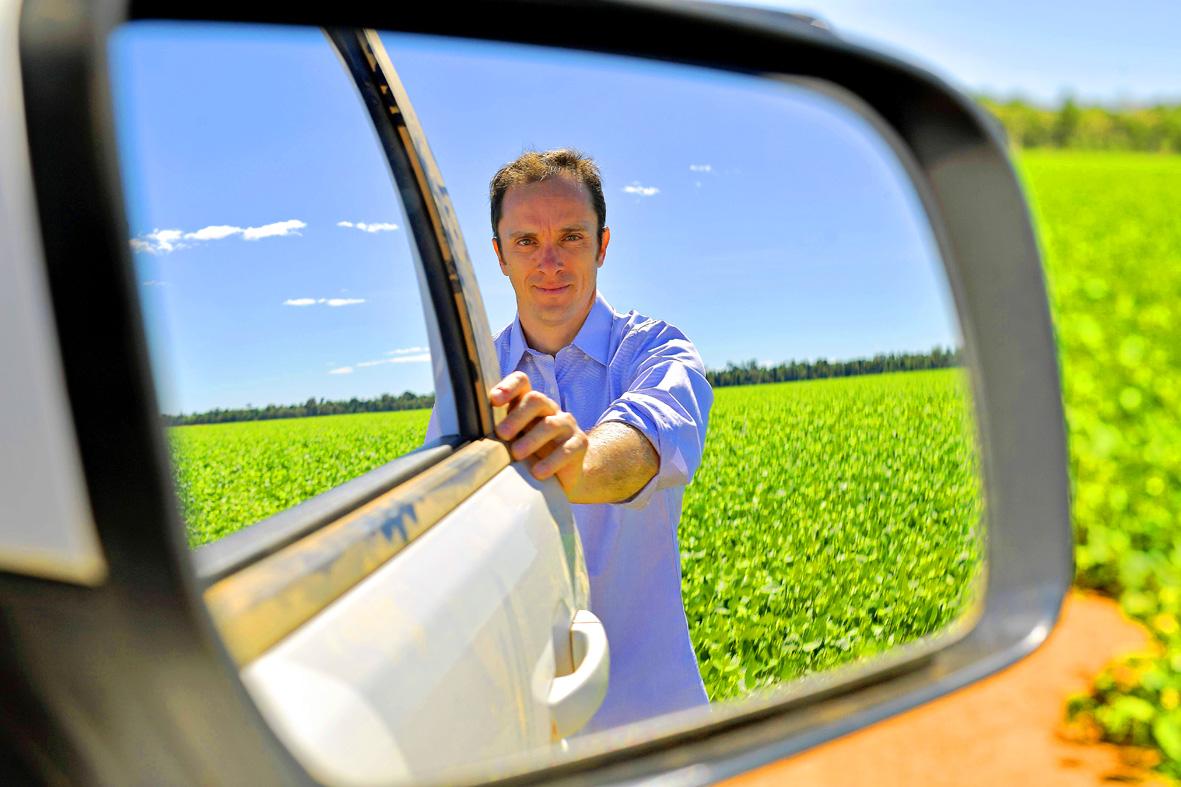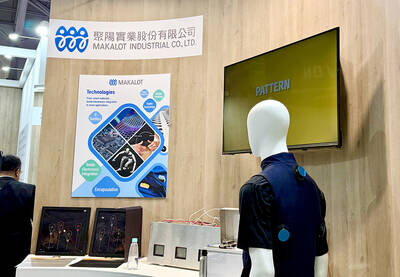Brazilian farmer Rodrigo Pozzobon drives his pickup truck toward his giant corn and soybean fields at the edge of the Amazon rainforest where, COVID-19 pandemic or not, business is booming thanks to surging demand from China.
Pozzobon has been racing to keep up with Chinese orders for chicken and pig feed, like many farmers in the greater Sorriso region, in the western state of Mato Grosso — a vast expanse of farms considered the capital of Brazil’s booming agribusiness industry.
“When this whole pandemic is over, I need a vacation,” said Pozzobon, an agricultural engineer, as he headed up the red dirt road to Jacana, his 2,350 hectare farm.

Photo: AFP
Latin America’s biggest economy is facing a record 6 percent recession this year because of the novel coronavirus, which has infected and killed more people in Brazil than in any country except the US.
Yet agribusiness, which accounts for more than one-fifth of the Brazilian economy, looks strikingly healthy, on track for revenue growth of 2 percent this year.
China is turning to Brazilian farmers more than ever because of its trade dispute with the US, not to mention a plunge in Brazil’s currency that has slashed the cost of its exports.
Battered by the economic fallout of the pandemic, the Brazilian real has fallen 25 percent this year against the US dollar.
That is bad news for consumers, but good news for exporters in places such as the Sorriso region, which is home to 1.5 million hectares of farmland — about half the size of Belgium.
This is a land of industrial farming and genetically modified crops, which are sold to big distributors such as Cargill Inc, Bunge Ltd and China National Cereals, Oils and Foodstuffs Corp (COFCO, 中糧集團).
Those corporations then sell them around the world, mainly to China, the destination for 72.6 percent of the region’s output so far this year, but there is a big blemish on that bright picture.
Brazilian agribusiness faces accusations of razing the Amazon, where there has been record deforestation in the first seven months of the year.
Flying over Mato Grosso farm country, the destruction of the rainforest is easily visible as scarred patches of bare land interrupt the lush vegetation.
Environmentalists say that farmers and ranchers are responsible for much of the destruction.
The issue has grown even more tense since the election of far-right Brazilian President Jair Bolsonaro, an advocate of opening up the world’s biggest rainforest to agriculture and industry.
Last year, in Bolsonaro’s first year in office, deforestation soared 85 percent in the Brazilian Amazon, to 10,123km2 of forest.
That loss — nearly the size of Lebanon — fueled worldwide alarm over the future of the rainforest, seen as vital to curbing climate change.
The destruction was driven by huge fires that raged across the Amazon from May to October, sending a thick haze of black smoke all the way to Sao Paulo, thousands of kilometers away, and triggering worldwide alarm.
Pozzobon, whose family arrived in the region with a wave of settlers in the 1970s, said that increasing agricultural production does not have to mean destroying the forest.
Millions of hectares of already deforested land being used to pasture livestock could be converted to crop land, he said, by way of example.
He also pointed to a recent regulation requiring large farms to leave 80 percent of their land fallow each year to reduce pressure on the environment.
“I admit, we have a past of sin. We’ve destroyed forest land. Some landowners cut down more trees than they were supposed to, but that’s been fixed, and we’ve paid the bill for harming the environment,” he said.
Facing international pressure to protect the forest, Bolsonaro has banned the use of fires to clear land.
Yet the practice is still occurring, as Agence France-Presse correspondents saw near the town of Sinop, where fires had burnt several fields and spread into the surrounding forest.
The ongoing problem has fueled fears that fires during this year’s dry season, which started last month, will be even worse than the ones that triggered global outcry last year.

Shares in Taiwan closed at a new high yesterday, the first trading day of the new year, as contract chipmaker Taiwan Semiconductor Manufacturing Co (TSMC, 台積電) continued to break records amid an artificial intelligence (AI) boom, dealers said. The TAIEX closed up 386.21 points, or 1.33 percent, at 29,349.81, with turnover totaling NT$648.844 billion (US$20.65 billion). “Judging from a stronger Taiwan dollar against the US dollar, I think foreign institutional investors returned from the holidays and brought funds into the local market,” Concord Securities Co (康和證券) analyst Kerry Huang (黃志祺) said. “Foreign investors just rebuilt their positions with TSMC as their top target,

H200 CHIPS: A source said that Nvidia has asked the Taiwanese company to begin production of additional chips and work is expected to start in the second quarter Nvidia Corp is scrambling to meet demand for its H200 artificial intelligence (AI) chips from Chinese technology companies and has approached contract manufacturer Taiwan Semiconductor Manufacturing Co (TSMC, 台積電) to ramp up production, sources said. Chinese technology companies have placed orders for more than 2 million H200 chips for this year, while Nvidia holds just 700,000 units in stock, two of the people said. The exact additional volume Nvidia intends to order from TSMC remains unclear, they said. A third source said that Nvidia has asked TSMC to begin production of the additional chips and work is expected to start in the second

REVENUE PERFORMANCE: Cloud and network products, and electronic components saw strong increases, while smart consumer electronics and computing products fell Hon Hai Precision Industry Co (鴻海精密) yesterday posted 26.51 percent quarterly growth in revenue for last quarter to NT$2.6 trillion (US$82.44 billion), the strongest on record for the period and above expectations, but the company forecast a slight revenue dip this quarter due to seasonal factors. On an annual basis, revenue last quarter grew 22.07 percent, the company said. Analysts on average estimated about NT$2.4 trillion increase. Hon Hai, which assembles servers for Nvidia Corp and iPhones for Apple Inc, is expanding its capacity in the US, adding artificial intelligence (AI) server production in Wisconsin and Texas, where it operates established campuses. This

Garment maker Makalot Industrial Co (聚陽) yesterday reported lower-than-expected fourth-quarter revenue of NT$7.93 billion (US$251.44 million), down 9.48 percent from NT$8.76 billion a year earlier. On a quarterly basis, revenue fell 10.83 percent from NT$8.89 billion, company data showed. The figure was also lower than market expectations of NT$8.05 billion, according to data compiled by Yuanta Securities Investment and Consulting Co (元大投顧), which had projected NT$8.22 billion. Makalot’s revenue this quarter would likely increase by a mid-teens percentage as the industry is entering its high season, Yuanta said. Overall, Makalot’s revenue last year totaled NT$34.43 billion, down 3.08 percent from its record NT$35.52